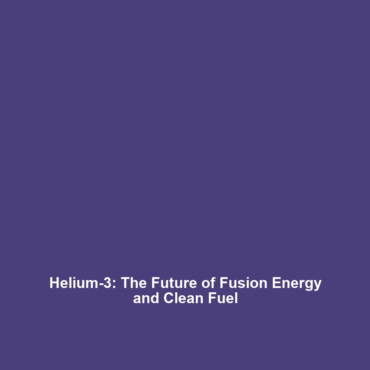Helium-3: The Future Fuel for Fusion Energy
Introduction
Helium-3 (He-3) is emerging as a potential game-changer in the quest for sustainable and clean energy solutions, particularly within the realm of fusion energy. Unlike conventional fossil fuels, Helium-3 offers a path to highly efficient energy production with minimal environmental impact. As scientists and engineers continue to study this isotope, its significance in the broader context of fusion energy becomes clearer, positioning it as a future fuel that could meet the world’s escalating power demands.
Key Concepts
Understanding Helium-3
Helium-3 is a rare isotope of helium that contains two protons and one neutron, distinguishing it from the more common Helium-4. In the context of fusion energy, Helium-3 can be fused with deuterium or itself to produce energy without the harmful byproducts associated with current nuclear fission technologies.
Fusion Energy Basics
Fusion energy is the process by which atomic nuclei combine to form a heavier nucleus, releasing vast amounts of energy. Helium-3 fusion is considered attractive due to its potential for cleaner reactions, which produce energy while eliminating radioactive waste.
Applications and Real-World Uses
Helium-3 holds promise for various applications in the field of fusion energy. Here are some key uses:
- Power Generation: Helium-3 fusion reactions could power future nuclear reactors, generating electricity with reduced waste products.
- Space Exploration: The isotope is considered for use in propulsion systems for spacecraft, offering a lightweight and efficient energy source.
- Medical Technologies: Helium-3 can be used in advanced imaging techniques, particularly in MRI machines.
Current Challenges
Despite the potential, several challenges hamper the development of Helium-3 as a reliable fuel:
- Scarcity: Helium-3 is not abundant on Earth, making extraction and supply a significant issue.
- Cost: The technology required to efficiently harness Helium-3 for fusion is in its infancy, and funding is a barrier to progress.
- Technical Complexity: Achieving the necessary conditions for fusion with Helium-3 remains a technical hurdle.
Future Research and Innovations
Looking ahead, several avenues of research are ripe for exploration:
- Advanced Reactors: Innovations in reactor design could improve the feasibility of Helium-3 fusion.
- Extraction Techniques: Developing efficient methods for extracting Helium-3 from lunar soil or gas giant atmospheres.
- International Collaboration: Increased cooperation among nations could accelerate fusion research and technology sharing.
Conclusion
Helium-3 represents a promising venture into the future of fusion energy, offering a cleaner and potentially unlimited energy source. While challenges remain, ongoing research and innovation may unlock the potential of this rare isotope. As we push forward in scientific discovery, understanding Helium-3’s role could pave the way for a new era of energy production. To learn more about fusion technologies and their applications, visit our related topics section.

